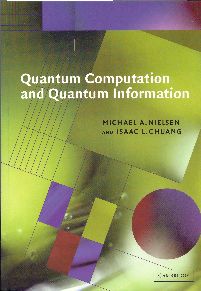Book Review

Quantum Computation and Quantum Information
Michael A. Nielsen and Isaac L. Chuang
Cambridge University Press, 2000, 676 pages
The Physics of Quantum Information
by Bouwmeester, Ekert, and Zeilinger (eds.)
Springer, 2000, 314 pages

 he potential processing power of a computer
based on quantum bits or qubits, if they could only be harnessed into
practical devices, is almost beyond comprehension. Because each qubit
contains a virtual universe of information inside it, a quantum computer,
if it could be built, could theoretically process 2n calculations
with only n operations. The only
problem is that, so far, the information cannot in principle be directly
accessed by any known method of measurement. These two books, aimed at
different audiences, do an excellent job at describing this subject,
which is a topic of intense research.
he potential processing power of a computer
based on quantum bits or qubits, if they could only be harnessed into
practical devices, is almost beyond comprehension. Because each qubit
contains a virtual universe of information inside it, a quantum computer,
if it could be built, could theoretically process 2n calculations
with only n operations. The only
problem is that, so far, the information cannot in principle be directly
accessed by any known method of measurement. These two books, aimed at
different audiences, do an excellent job at describing this subject,
which is a topic of intense research.
The Physics of
Quantum Information by Bouwmeester, Ekert, and Zeilinger (eds.)
pays close attention to the physical aspects of the subject, enabling
the reader to understand the actual experiments on which the theories
are based. The book has 125 photographs of actual data and diagrams of
experimental setups, and adheres more closely to its subject than Nielsen
and Chuang, which makes this book more concise (314 pages including the
index). After a brief introduction to basic concepts, the book goes
directly to quantum cryptography, teleportation, and computation, always
maintaining an emphasis on the subject's grounding as an experimental
science. The remaining chapters cover more advanced topics such as
multi-particle entanglement and decoherence.
Quantum Computation and Quantum Information, on the other hand,
is a thorough textbook on the fundamentals of the subject, suitable for
a one-semester graduate-level course. Because of the interdisciplinary
nature of the subject, the authors included convenient chapters on
"Introduction to quantum mechanics", "Introduction to Computer Science",
and large separate chapters on classical and quantum information theory.
There are also chapters on quantum circuits, physical realization, quantum
noise, distance measures, error-correction, and brief appendices on topics
that workers in the field might need to know, such as group theory, number
theory, and RSA encryption.
Although Nielsen and Chuang include a large amount of non-quantum
background material, which accounts for much of the book's greater size,
the level of presentation is no less rigorous than in Bouwmeester
et al. However, the subject is covered in a more abstract
way, and except for a few vague descriptions of optical gates and
a discussion of quantum chemistry and NMR from a physicist's point
of view in the chapter on physical realization, there are almost no
references to lasers, ions, photons, and interferometers that are
the stuff of Bouwmeester's book.
Both books seem to take pains, with varying levels of success, to
minimize pulling equations out of hats, using functions without
defining them, and leaving derivations as "exercises for the
reader" that abound in other books on topics in mathematical physics.
Nielsen and Chuang are, if anything, overenthusiastic about the
subject, with a more liberal use of exclamation points than the
more formal Bouwmeester et al. A professional or student entering
the field of quantum information should probably read both books.
However, even the casual reader, with a little effort, can learn a
great deal about this exciting subject from either book.

November 17, 2002
Back
 he potential processing power of a computer
based on quantum bits or qubits, if they could only be harnessed into
practical devices, is almost beyond comprehension. Because each qubit
contains a virtual universe of information inside it, a quantum computer,
if it could be built, could theoretically process 2n calculations
with only n operations. The only
problem is that, so far, the information cannot in principle be directly
accessed by any known method of measurement. These two books, aimed at
different audiences, do an excellent job at describing this subject,
which is a topic of intense research.
he potential processing power of a computer
based on quantum bits or qubits, if they could only be harnessed into
practical devices, is almost beyond comprehension. Because each qubit
contains a virtual universe of information inside it, a quantum computer,
if it could be built, could theoretically process 2n calculations
with only n operations. The only
problem is that, so far, the information cannot in principle be directly
accessed by any known method of measurement. These two books, aimed at
different audiences, do an excellent job at describing this subject,
which is a topic of intense research.


